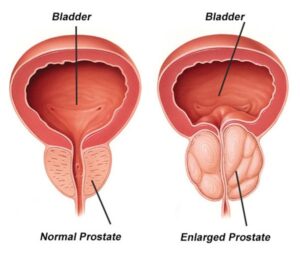



Benign Prosthetic Hypertrophy
Prostatic hypertrophy, more commonly referred to as benign prostatic hyperplasia (BPH), is a common condition in older men characterized by the non-cancerous enlargement of the prostate gland. This condition can lead to significant urinary symptoms and impact the quality of life. Understanding BPH involves exploring its causes, symptoms, diagnosis, treatment options, and management strategies.
Anatomy and Function of the Prostate
The prostate is a small, walnut-sized gland located below the bladder and in front of the rectum. It surrounds the urethra, the tube through which urine exits the bladder. The primary function of the prostate is to produce seminal fluid, which nourishes and transports sperm during ejaculation.
Causes of BPH
The exact cause of BPH is not entirely understood, but it is believed to be linked to hormonal changes as men age. Specifically, changes in the balance of sex hormones, including testosterone and estrogen, might contribute to prostate growth.
-
- Hormonal Changes: As men age, the levels of active testosterone in their blood decrease, leading to a higher proportion of estrogen. This imbalance may promote the growth of prostate cells.
-
- Dihydrotestosterone (DHT): Another theory suggests that the accumulation of DHT, a testosterone derivative, within the prostate may cause it to enlarge. Older men continue to produce and accumulate high levels of DHT in the prostate.
Symptoms of BPH
The symptoms of BPH result from the enlarged prostate pressing against the urethra and obstructing urine flow. Common symptoms include:
-
- Frequent Urination: Especially noticeable at night (nocturia).
-
- Urgency: A sudden, strong urge to urinate.
-
- Weak Urine Stream: Decreased force of the urine stream.
-
- Dribbling: Post-void dribbling of urine.
-
- Incomplete Emptying: Feeling that the bladder is not completely empty after urination.
-
- Straining: Needing to strain to start urination.
Diagnosis of BPH
Diagnosing BPH typically involves several steps:
-
- Medical History and Physical Exam: A thorough medical history and physical examination, including a digital rectal exam (DRE), help evaluate the size and condition of the prostate.
-
- Urinalysis: A urine test to check for infection or other conditions that might cause similar symptoms.
-
- Prostate-Specific Antigen (PSA) Test: A blood test to measure PSA levels, which can be elevated in BPH but is also used to screen for prostate cancer.
-
- Ultrasound: An abdominal or transrectal ultrasound to assess the prostate’s size and rule out other conditions.
-
- Uroflowmetry: A test that measures the strength and amount of urine flow.
-
- Post-Void Residual Volume: Measuring the amount of urine left in the bladder after urination.
Treatment Options for BPH
Dr.Shankar MS, Mch Consultant Urologist is an expert in handling cases which need timely intervention and takes case based decision.The treatment for BPH depends on the severity of symptoms and the degree to which they affect quality of life. Treatment options include lifestyle changes, medications, minimally invasive procedures, and surgery.
Lifestyle Changes
-
- Fluid Management: Reducing fluid intake, especially before bedtime, to decrease nocturia.
-
- Bladder Training: Techniques to improve bladder control and reduce urgency.
-
- Dietary Adjustments: Limiting caffeine and alcohol, which can irritate the bladder.
Medications
-
- Alpha Blockers: Medications like tamsulosin and alfuzosin relax the muscles of the bladder neck and prostate, improving urine flow and reducing symptoms.
-
- 5-Alpha Reductase Inhibitors: Drugs like finasteride and dutasteride shrink the prostate by blocking the hormonal changes that cause prostate growth.
-
- Combination Therapy: Using both alpha blockers and 5-alpha reductase inhibitors for more effective symptom relief.
Minimally Invasive Procedures
-
- Transurethral Microwave Thermotherapy (TUMT): Uses microwave energy to heat and destroy excess prostate tissue.
-
- Transurethral Needle Ablation (TUNA): Uses radiofrequency energy to burn away excess tissue.
Surgical Options
Transurethral Resection of the Prostate (TURP): The most common surgical treatment, involving the removal of prostate tissue using a resectoscope inserted through the urethra.
Management and Follow-Up
Managing BPH is a long-term process that requires regular monitoring and follow-up. Patients are advised to:
-
- Regular Check-Ups: To monitor prostate size and symptom progression.
-
- Symptom Tracking: Keeping a diary of symptoms and urinary habits.
-
- Medication Adherence: Consistently taking prescribed medications and reporting any side effects.
-
- Healthy Lifestyle: Maintaining a healthy diet, regular exercise, and avoiding bladder irritants.
Complications of Untreated BPH
If left untreated, BPH can lead to serious complications, including:
-
- Acute Urinary Retention: Sudden inability to urinate, which is a medical emergency.
-
- Chronic Urinary Retention: Gradual loss of bladder function.
-
- Urinary Tract Infections (UTIs): Due to incomplete bladder emptying.
-
- Bladder Stones: Resulting from residual urine.
-
- Kidney Damage: Due to back pressure on the kidneys from urine retention.
Conclusion
Benign prostatic hyperplasia is a prevalent condition among aging men, significantly impacting urinary function and quality of life. While it is a non-cancerous enlargement, the symptoms can be distressing and require medical attention. Early diagnosis and a comprehensive treatment plan tailored to the individual’s symptoms and health status are crucial. With advancements in medical treatments and surgical options, most men can find relief from BPH symptoms and maintain a good quality of life. Regular follow-ups and lifestyle modifications play a significant role in managing this condition effectively. https://journals.lww.com/indianjurol/pages/default.aspx











